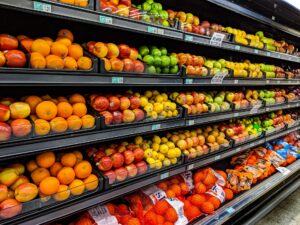Neil Chambers
As a supermarket or retail store you have customers in your store every day, this can be good for business but can lead to issues if there are hazards in your store. Without insurance or following procedures, your store can be held liable if a customer should hurt themselves while on your premises.
The main areas to consider when talking about prevention and supermarket insurance or retail insurance are slips, trips and falls, spillage, CCTV footage and aisle checks. You need to ensure your store is equipped to follow procedure if an incident occurs but you also need to be active in removing any hazards before they become dangerous to customers.
SLIPS TRIPS AND FALLS
In some cases, it’s simple bad luck that a customer might slip, trip or fall in a supermarket or retail store. In other cases, it can be because of the store’s negligence that a customer has hurt themselves, but we will dive deeper into that in aisle checks.
If a customer does slip, trip or fall while in the premise of the store, it is important that they are offered immediate assistance by the team members in the store. A senior staff member should attend the scene and the customer to ensure the correct procedures are followed. Any injuries to the customer must be attended to according to your store’s first aid incidence guidelines. A senior staff member is then required to complete an incident report form, even if there is no apparent injury to the customer. By filling out the correct incident report form this could help protect you under your supermarket or retail insurance claims.
SPILLAGE
To avoid any slips, trips or falls in your store it is important to address any hazards before they become an accident or claim. If a spill occurs in your store, staff members should address it immediately and direct customers around the area of spillage to avoid any slips while the cleaning materials are collected by other staff. The spill should be addressed and cleaned appropriately and a wet floor sign must be erected.
CCTV
If a slip of a fall incident does occur, it is important that the Store Manager should review the relevant CCTV footage as soon as possible. If the customer decides to lodge a claim for injury and other damages, having the CCTV footage of the incident will be critical in the case. Having recorded evidence of the customer’s fall or slip will document your store’s reaction procedures and the events that led up to the fall. From this footage, it can then be used as evidence in your case.
Not having this footage could lead to your store being sued for damages even if you followed correct procedures as you might not have any evidence to prove so. In having this evidence, you can prove that your store was following the correct procedures and avoid being held liable for a slip, trip or fall.
AISLE CHECKS
As mentioned earlier, the best way to avoid an incident is following procedures and keeping your store free of hazards. Staff members should be trained with procedures in place to observe regular checks of all aisles looking for any items on the floor or possible spills. To keep track of these checks, a logbook can be kept with a record of when these are done.
By keeping your store clean and free of trip hazards or spills you significantly reduce the chance of a customer injury. In recording the times and aisles checked in a logbo ok you can help provide evidence if a customer lodges a complaint or claim for injury within an aisle you have checked.
ok you can help provide evidence if a customer lodges a complaint or claim for injury within an aisle you have checked.
Why are these procedures important?
To demonstrate how these procedures can help you with your supermarket insurance or retail insurance, take a look at the examples below.
Example One:
A woman fell in a supermarket but felt okay at the time so a report was not filed. She returned to her workplace with the items that she purchased on behalf of the business. The woman told her manager about her fall while in the supermarket and he sent her off to go and see a doctor and they lodged a worker’s compensation claim.
Eighteen months later Work Safe submitted a demand on the supermarket for lost wages and medical expenses of $150,000. There was no record in the supermarket that the fall had occurred but the incident was still a liability claim.
Example Two:
A junior staff member while doing an aisle check found a broken olive oil bottle on the floor. They quickly dashed off to retrieve the cleaning equipment without alerting anyone of the spillage on the ground. A customer walked into the aisle before the staff member returned to clean up and the customer slipped on the olive oil. As procedures were not followed the supermarket was held liable.
Example Three:
A woman was found lying on the floor in an aisle and very distressed. The Store manager was aware that there had been a spillage in the aisle previous to finding the woman and
they assumed that the spill had not been cleaned correctly. However, when the Store Manager went to view the CCTV footage, they noticed that the spill had been cleaned and a wet floor sign had been erected. They saw that the woman entered the aisle, collapsed the sign and slid it under the shelves before she laid down on the ground and began screaming.
This example without footage would have held the supermarket liable for an injury claim, however with the evidence of CCTV footage they had proof the correct procedures were followed by their staff.
footage would have held the supermarket liable for an injury claim, however with the evidence of CCTV footage they had proof the correct procedures were followed by their staff.
Supermarket insurance and retail insurance is important to have as you can see through these examples. You don’t want your store to become responsible for a customer’s injury or liability claim. By following your store’s procedures, training staff and using the tips above, you can help reduce the chance of the unexpected happening and be prepared.




